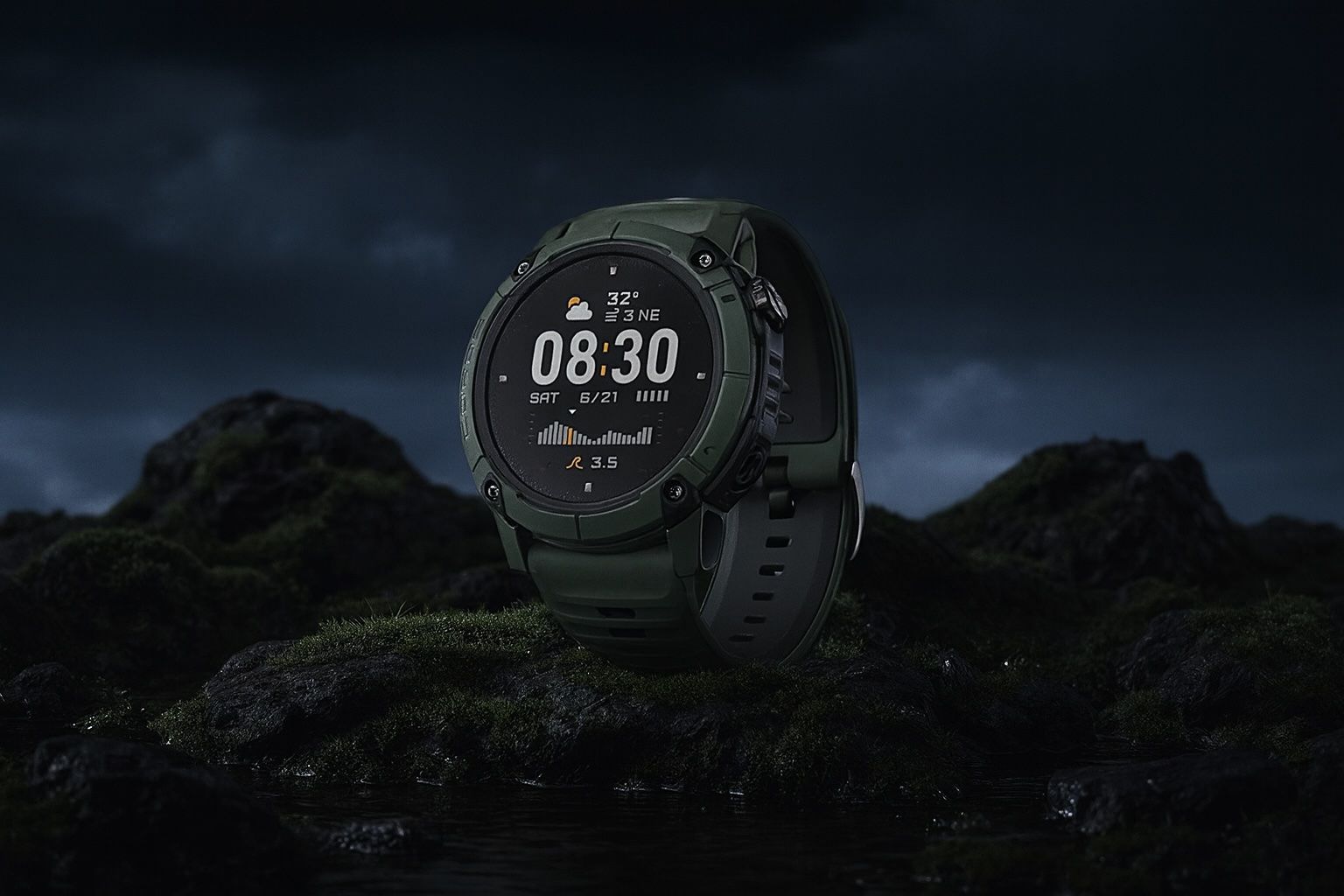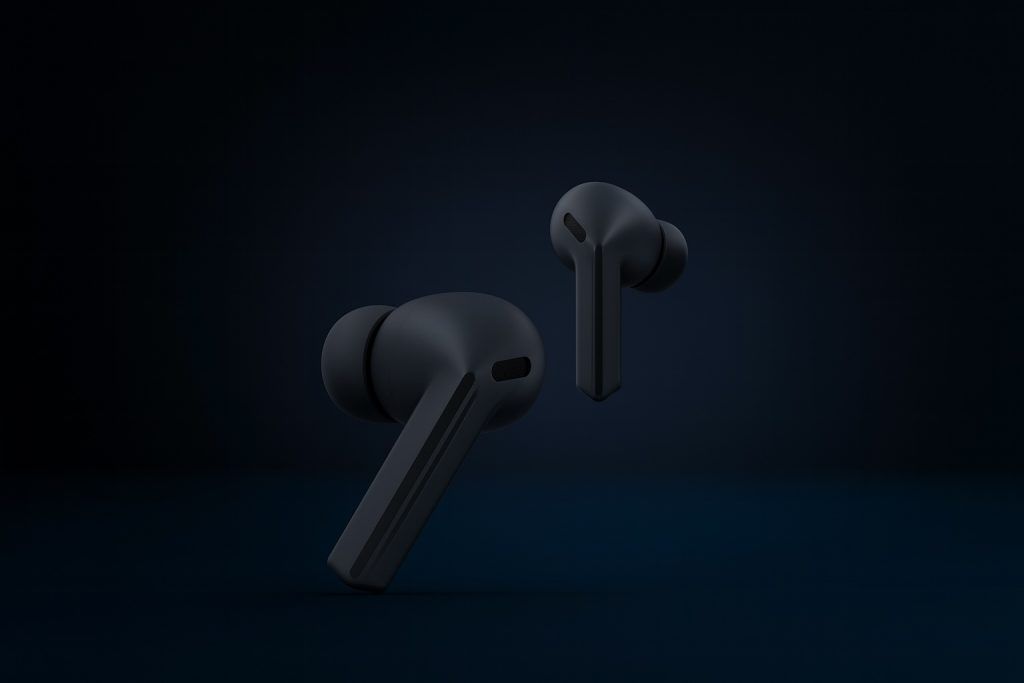- The COROS Nomad, a rugged GPS multisport watch, launched in August 2025.
- Priced at $349 USD (about £319/€369), it undercuts many competitors while offering full-color offline maps, voice notes, and music playback.
- Battery life runs to up to 22 days in everyday use, about 50 hours in GPS mode, and around 34 hours with dual-frequency GPS.
- It features a 1.3-inch Memory-In-Pixel display at 260×260 with an always-on, high-contrast panel for sun readability.
- Build specs include a 47.8 mm case diameter, about 61 g with a silicone band (49 g with nylon), a dual-layer aluminum-reinforced polymer bezel, hardened mineral glass, and 5 ATM water resistance.
- On-device mapping includes full-color offline maps with 32 GB onboard storage for maps, routes, and music, plus planning and turn-by-turn directions and a Back to Start feature.
- The Adventure Journal lets you record voice notes and attach photos or markers to routes via a built-in microphone for storytelling of your trip.
- Eight dedicated fishing modes let you log catches, mark hotspots, and access environmental data like tide times, moon phases, barometric pressure, and weather forecasts to suggest the best fishing times.
- Health and training sensors include optical heart rate, SpO2, ECG, skin temperature, an altimeter, a barometer, and a 3D compass, with 50+ activity profiles and rolling 7-day training-load analytics.
- Connectivity includes Bluetooth and Wi-Fi with compatibility for external sensors, plus Extender mode to view the live map on a phone, while there is no LTE or on-device payments.
The COROS Nomad is a brand-new GPS multisport watch making waves in the outdoor and fitness community. Launched in August 2025, the Nomad is purpose-built for adventure seekers – think hikers trudging through backcountry trails, trail runners, mountain bikers, backpackers, and even anglers casting in remote waters [1] [2]. This rugged smartwatch aims to be a “do-it-all” companion for off-grid expeditions, combining advanced navigation tools, long-lasting battery life, and unique features like voice-logged journaling and fishing-specific modes. Priced at $349 USD (about £319/€369), it undercuts many competitors while packing in capabilities that rival (or exceed) pricier models [3] [4].
Visually, the Nomad might remind you of the Garmin Instinct series – it sports a chunky, utilitarian design with a reinforced bezel and durable build [5]. But beneath that familiar look, COROS has gone above and beyond to deliver a watch loaded with tech that adventurers crave. As one reviewer put it, “it’s a classic case of COROS going above and beyond” – offering features like full-color offline maps, voice notes, and even music playback that Garmin’s Instinct line “has nothing approaching” [6]. In this report, we’ll break down what the Nomad offers, who it’s for, how it stacks up against Garmin, Suunto, Polar and others, and what experts and early users are saying about this “game-changing” adventure watch.
What Is the COROS Nomad and Who Is It For?
The COROS Nomad is an GPS multisport smartwatch designed explicitly for outdoor adventures and endurance activities. In COROS’s lineup, the Nomad fills a new niche as their first truly rugged “adventure watch,” complementing the brand’s Pace series (focused on runners) and Vertix series (high-end mountaineering watches) [7]. According to COROS, the Nomad is “purpose-built for outdoor adventurers” with tools tailored to hikers, climbers, anglers, and more [8]. In other words, if your activities take you off the grid – whether trekking through mountains, navigating forest trails, backpacking for days, or fishing on a remote lake – this watch was built with you in mind.
Who will love the Nomad? Off-grid explorers and endurance athletes are top of the list. The watch’s exceptional battery life (more on that below) makes it ideal for thru-hikers and ultramarathon runners who need a device that can keep up for days [9]. Mountain bikers, trail runners, and backcountry skiers will appreciate its robust navigation and tracking features. Uniquely, COROS also targets anglers: the Nomad is one of the first GPS watches to offer dedicated fishing modes, making it attractive to fishing enthusiasts who want to log catches and environmental conditions [10] [11].
That said, you don’t have to be a hardcore outdoorsperson to benefit from the Nomad. It’s still a full-featured multisport watch that tracks everyday workouts (running, cycling, gym sessions, triathlons, etc.) with plenty of training metrics. As Tom’s Guide noted after a month of testing, while the Nomad is built for outdoor adventure – “it has 10 types of fishing sports modes, for example” – it’s also “a great option for runners and triathletes who like the look of the watch and value long battery life.” [12] In short, the Nomad is for anyone who wants a rugged, long-lasting sports watch with advanced navigation, whether your adventures involve summiting peaks, running a marathon, or just exploring new trails on the weekends.
Key Features and Specifications
Despite its mid-range price, the COROS Nomad comes loaded with features and tech. Here’s an overview of its key specifications and what makes it stand out:
- Rugged Design and Build: The Nomad is built to endure harsh environments. It uses a dual-layer aluminum-reinforced polymer bezel for toughness, and a hardened mineral glass lens on the display [13]. While it’s not sapphire crystal, COROS chose mineral glass because it’s highly scratch-resistant and less likely to shatter – a practical choice for outdoor use [14]. The watch is 5 ATM water-resistant (good for 50m depth), plenty for swimming or watersports [15]. At 47.8 mm diameter and weighing about 61 g with the silicone band (or ~49 g with a nylon strap), it’s robust but still lightweight for its size [16] [17], avoiding the “brick on the wrist” feeling some heavy-duty watches have [18].
- High-Visibility Display: It features a 1.3-inch Memory-In-Pixel (MIP) touchscreen (260×260 resolution) [19]. MIP is similar to the tech in Garmin’s Instinct – chosen for its clarity in bright sun and low power draw. COROS uses a new high-contrast panel that improves color saturation and readability in all light conditions [20]. The screen is always-on and easy to read under sunlight, which is crucial for outdoor adventures. (Unlike AMOLED screens, which can appear washed out in sun and consume more battery, MIP helps the Nomad achieve its epic battery life [21].)
- Epic Battery Life: Battery longevity is a major selling point. The Nomad boasts up to 22 days of everyday use on a charge [22]. For GPS activities, it can last around 50 hours in standard full GPS mode (all systems GNSS) and about 34 hours with dual-frequency GPS enabled [23]. These figures blow past the Garmin Instinct 3’s advertised 18 days smartwatch use and 32 hours GPS in a comparable mode [24]. In real-world testing, the Nomad’s battery has even exceeded the specs – for example, handling long multi-day treks with battery to spare [25] [26]. Such stamina makes it reliable for multi-day hikes or ultraruns without worrying about charging. (For extreme expeditions, COROS also includes a tiny keychain-sized USB-C charger accessory so you can top-up on the go [27].)
- Dual-Frequency GPS and Navigation: The Nomad is equipped with dual-frequency (multi-band) GNSS capability for superior tracking accuracy [28]. It can lock onto multiple satellite constellations (GPS, GLONASS, Galileo, Beidou, QZSS) simultaneously, and the dual-band mode helps in challenging environments like deep canyons or dense forests by reducing signal distortion [29] [30]. Navigation features are a highlight: the Nomad offers full-color offline maps with global coverage, downloadable via COROS’s app. It comes with a generous 32 GB of onboard storage, used for maps, routes, and even music files [31]. Unlike many competitors in this price range, it can display detailed topo maps with street names, trails, and Points of Interest (POI) right on your wrist [32] [33]. You can plan or import routes (from Strava, Komoot, etc.) and get turn-by-turn directions, plus alerts if you go off-route [34] [35]. There’s a handy “Back to Start” function that navigates you back to your starting point along your track [36]. Impressively, COROS’s new Gen3 processor in the Nomad makes map browsing smooth – zooming and panning the map on the watch is fast and with minimal lag [37]. (The digital dial/crown on the side helps scroll and zoom the maps easily during an activity [38].) All maps and navigation features are included free – no extra subscription or premium model needed, which underlines COROS’s value proposition [39] [40].
- “Adventure Journal” – Voice Notes, Photos, and Memories: Perhaps the most unique feature on the Nomad is COROS’s new Adventure Journal. This is a suite of tools that let you capture more than just data during your activities. You can drop location pins, record voice notes, and attach photos/videos (via the phone app) to your recorded routes [41] [42]. For example, with a quick press you can record an audio note about a beautiful viewpoint or trail condition; the watch has a built-in microphone (the first COROS watch to include one) to capture your voice memos [43]. Later, in the COROS app, you’ll see your route with markers where you took notes or pictures, allowing you to relive the experience rather than just see stats [44]. Reviewers found this feature surprisingly fun and useful – one tester noted that their voice notes were transcribed accurately, and it was great to see an entire outing “laid out like a story” with route, conditions, photos, and notes all in one [45] [46]. COROS’s CEO Lewis Wu explained they built Nomad to give adventurers a way to capture memories without compromising performance, saying “It can’t replace being outdoors, but it can help you remember what it felt like to be there.” [47] [48].
- Fishing Modes and Environmental Insights: Another standout is the Nomad’s focus on fishing – a demographic often overlooked by high-end sports watches. It offers eight dedicated fishing modes (covering types like fly fishing, lure, boat fishing, shore fishing, etc.) to track your outings [49]. You can log catches (species, weight, etc.), mark fishing hotspots, and even get environmental data relevant to anglers, such as tide times, moon phases, barometric pressure, and weather forecasts for your location [50] [51]. The watch can help predict the “best fishing times” based on these factors and alert you to movements (useful if you’re waiting for a bite) [52]. This is a truly niche feature – as one hunting/fishing editor noted, the Nomad is “the first smart watch to offer fishing settings,” filling a real gap for anglers who want to track their outings [53]. Even if you’re not a fisher, these additions demonstrate COROS’s broader approach to adventure sports beyond the usual run/bike/tri metrics.
- Health and Training Features: The Nomad doesn’t skimp on sensors and fitness tracking either. It has the full array of health monitors: an optical heart-rate sensor, blood oxygen (SpO₂) sensor, and even an electrocardiogram (ECG) sensor for heart health checks [54]. The inclusion of ECG is rather uncommon in pure adventure watches – it’s a feature more often seen on lifestyle smartwatches, marking a nice bonus for health-conscious users [55]. There’s also a skin temperature sensor, altimeter, barometer, and 3D compass built-in [56], providing real-time environmental data like ambient temp, altitude, air pressure and storm alerts (useful on mountain treks) [57]. On the training side, the Nomad tracks all the usual metrics – pace, distance, cadence, laps, etc. – and provides features like training load and recovery analysis to help you monitor your fitness over time [58]. (Notably, COROS updated the Nomad to use a rolling 7-day training load view, instead of resetting weekly, responding to feedback for more useful metrics [59] [60].) The watch supports 50+ activity profiles from common ones like running, cycling, swimming, to niche ones like pilates, windsurfing, and even triathlon and multi-sport modes [61] [62]. All data syncs to the COROS smartphone app, which is well-regarded for its clean interface and powerful route-planning and analytics tools [63] [64].
- Smartwatch Functions: While the Nomad is adventure-focused, it does offer everyday smart features. You get smartphone notifications, alarms, timers, a compass widget, “find my phone/watch” features, weather forecasts, and music controls [65] [66]. Impressively, you can also store music on the watch itself – up to 32 GB worth of MP3 files – and play them via Bluetooth headphones (COROS doesn’t support streaming services yet, so you load your own MP3s) [67] [68]. There’s no built-in LTE/cellular or contactless payments on the Nomad (those features are typically found in more smartwatch-oriented devices), but you can still log workouts and then sync when you have your phone or WiFi connection. Speaking of connectivity, the Nomad has Bluetooth and WiFi for syncing and firmware updates, and can connect to Bluetooth fitness sensors like chest heart-rate straps or cycling cadence sensors. (It does not support ANT+ sensors, since COROS has opted to use Bluetooth only for accessories [69].) Also, COROS introduced an Extender mode – a kind of phone mirroring – which allows you to view and control the live map on your phone during an activity if you want a larger screen, e.g., mounting your phone on a bike handlebar for navigation while the watch logs data [70] [71]. This gives some extra flexibility for cyclists or those who prefer a bigger map view in certain cases.
In summary, the Nomad’s spec sheet is remarkably robust for its price. Full color maps, dual-band GPS, 32 GB storage, voice note capabilities, an ECG sensor, and multi-week battery life is a combination you’d typically have to pay premium prices for (or might not find at all in one device). COROS has clearly thrown down a challenge to the incumbents with this feature-packed adventure watch.
How It Stacks Up Against the Competition
The COROS Nomad enters a competitive field of adventure-oriented sports watches. Here’s how it compares to some of its main rivals from Garmin, Suunto, and Polar (and others):
- Garmin Instinct 3 Series: Garmin’s Instinct is the obvious comparison – in fact, Nomad’s design and target audience are very similar. The Garmin Instinct 3 (launched 2023) earned praise for its rugged build, long battery, and reliable tracking, and it comes in multiple variants (including a Solar-charging model and a higher-res AMOLED model) [72] [73]. However, COROS has deliberately positioned the Nomad as a more affordable yet feature-rich alternative. The Nomad’s $349 price is about $50–$150 cheaper than the Instinct 3 models (which range from ~$399 for base MIP up to $499 for AMOLED) [74] [75]. More importantly, COROS includes features that Garmin omitted on the Instinct: for example, the Nomad has full-color offline maps, whereas no Instinct model offers on-device mapping [76]. The Nomad also has music storage/playback and voice memo capabilities – again, things the Instinct 3 line doesn’t provide [77]. Garmin arguably held those features back to differentiate its higher-end Fenix/Epix series, but COROS put them into a mid-range watch. In terms of battery, Nomad actually beats the Instinct 3 slightly (22 days vs ~18 days smartwatch use; 50 hours vs ~32 hours GPS) [78] [79], unless you count Garmin’s solar boost in ideal conditions. Garmin’s advantages? The Instinct 3 has a few hardware perks the Nomad lacks: for instance, a built-in LED flashlight on certain models, a higher 10 ATM water resistance rating (100m vs Nomad’s 50m) and compliance with military MIL-STD-810 for extreme durability [80]. Garmin also offers multiple size options (the Instinct 3 comes in a standard 50mm and a smaller 45mm size, including an AMOLED 1.3″ version) and solar charging editions for essentially unlimited runtime in sunlight [81] [82]. On the software side, Garmin has its vast Connect IQ app ecosystem and more extensive training and wellness metrics (like daily suggested workouts, recovery advisor, HRV status, etc.) [83] [84]. It also supports contactless payments (Garmin Pay) and has features like phone-free Spotify music (on some models) and incident detection – features Nomad doesn’t have. In short, if you want robust mapping and unique tools like fishing modes, the Nomad gives you more for less money. But if you need Garmin’s extras (flashlight, apps, or an AMOLED display with solar), you might still consider paying a premium for the Instinct. For many people, though, COROS’s offering will cover all the essentials. As DC Rainmaker concluded, “for many people, there’s probably little reason to spend an extra $50-$150 for the Garmin Instinct 3, especially if you want offline mapping” [85]. The Nomad goes head-to-head with Garmin’s Instinct and makes a compelling case as the value pick in this category.
- Suunto (Race, Vertical, etc.): Suunto has been another major player in outdoor watches. Recently, Suunto introduced models like the Suunto Race (and Race S) and Suunto Vertical, which brought features like dual-frequency GPS and even full offline maps (a first for Suunto) to their lineup in 2023. The Suunto Race in particular has a bright AMOLED display with mapping and is aimed at adventure runners. However, Suunto’s devices tend to be priced higher – the Race launched around $499 or more, and the flagship Vertical was even pricier (though it boasts exceptional battery life with solar). The COROS Nomad holds its own against these: it matches or exceeds the spec sheet (multi-band GNSS, maps, long battery) at a significantly lower price point. In fact, Ray Maker noted that the Nomad “competes well against not just Suunto’s [Race series], but also head-on versus the Garmin Instinct 3”, essentially covering both bases [86]. One area Suunto historically excelled is build materials (some models have sapphire glass and titanium) and certain niche metrics (like very granular training load and recovery in Suunto’s app). But COROS has closed much of that gap, even adding features like ECG that Suunto doesn’t have. Unless a user is specifically loyal to Suunto’s platform or wants an AMOLED display (with its more vibrant looks) despite shorter battery, the Nomad presents a very strong alternative. It’s telling that the Nomad’s launch will likely put pressure on Suunto’s pricing; as one report quipped, COROS has “pretty much killed any product-spec reason to buy the COROS Apex 2 [their older mid-range]” and by extension makes older Suunto offerings look less compelling too [87] [88].
- Polar Grit X / Grit X2: Polar’s entry in the adventure watch space was the Polar Grit X and Grit X Pro, known for solid build and training analytics (Polar is known for heart rate accuracy and coaching features). However, Polar’s first Grit X (2020) notably lacked onboard maps – it only had breadcrumb navigation. The updated Grit X Pro (2021) added durability (sapphire glass, etc.) but still no full maps. This is where the COROS Nomad leapfrogs Polar: it offers true maps and multi-band GPS that Polar hadn’t included in that class. Interestingly, Polar just announced a new Grit X2 in mid-2025, finally adding a full-color AMOLED display and mapping, in a play to keep up with Garmin and COROS [89]. But Polar’s new model comes at a steep price (around £399, roughly $540) and is positioned more as a premium product [90]. The Nomad undercuts that drastically at $349. Feature-wise, the Nomad and Grit X2 might share some navigation capabilities now, but COROS still has unique ones like voice journaling and all those fishing modes that Polar doesn’t touch. Polar’s watches do offer things like running performance tests, Recovery Pro, and a strong focus on training load and planning – beneficial for serious athletes. They also integrate well with Polar’s Flow app for coaching. But for the outdoors explorer on a budget, Nomad offers more bang per buck. As TechRadar noted, the Nomad delivers a strong feature set “at $349 – less than the most affordable Garmin Instinct 3” and by extension cheaper than Polar’s mapping watch too [91]. Unless you specifically want Polar’s ecosystem, the Nomad stands as a more economical choice that doesn’t sacrifice major adventure features.
- Others (Amazfit & Smartwatches): It’s worth mentioning Amazfit’s T-Rex 3 (and similar rugged smartwatches) as lower-cost alternatives. The Amazfit T-Rex 3, for example, is a rugged outdoor-themed watch often priced under $200. It has great battery life and basic GPS, but it’s more of a fitness smartwatch hybrid – lacking the detailed mapping, advanced navigation, or sensor precision that the Nomad offers [92]. The Nomad is in a different league when it comes to serious training and navigation, so while an Amazfit might suffice for casual hikers, it’s not directly comparable for expedition use. And of course, an Apple Watch Ultra or Garmin Fenix could be considered competition too (they are aimed at adventurers), but those are much more expensive ($700+). The Apple Watch Ultra 2, for instance, has tons of smart features and an amazing screen, yet even it doesn’t natively support offline topo maps without third-party apps, and its battery lasts only a couple of days – a very different product. The Garmin Fenix/Epix series are superb but again start around $600 and up. The COROS Nomad is more about democratizing those adventure features at a mid-range price. It might not have every luxury (no AMOLED, no contactless pay, etc.), but it covers the core needs for outdoor adventuring extremely well.
In summary, COROS has positioned the Nomad as a serious contender in the adventure watch space. It delivers mapping and multi-band accuracy at a price point that undercuts Garmin’s Instinct 3 and Suunto’s offerings. There are trade-offs (Garmin and others still offer some bells and whistles Nomad doesn’t), but COROS is clearly targeting the enthusiast who cares about navigation, battery life, and core performance more than smartwatch frills. Early impressions suggest the Nomad is indeed meeting that mark, and it will be interesting to see how the competition responds in this sub-$400 adventure watch category.
Expert Reviews and Opinions
The COROS Nomad has generated a lot of buzz in the sports tech community. Here’s a look at what expert reviewers are saying:
- DC Rainmaker (Ray Maker): Ray’s in-depth review was very positive about the Nomad’s value and performance. He noted that while at first glance one could mistake the Nomad for a Garmin Instinct, it actually “might look like a Garmin Instinct, but it’s a classic case of COROS going above and beyond.” He highlighted that at $349, the Nomad is “$50-$150 cheaper” than Garmin’s Instinct 3, yet offers “full-blown color maps (Instinct has none). And voice notes… and music playback. And a slate of new fishing modes”, features Garmin simply doesn’t offer on that line [93]. In his wrap-up, DC Rainmaker concluded the Nomad is a “fantastic watch” that puts COROS on a winning streak, effectively eliminating reasons to buy COROS’s own higher-end Apex 2 given the Nomad’s superior feature set [94]. He also found it to be COROS’s most accurate GPS watch yet, with battery life exceeding expectations on long treks [95]. Minor critiques he had were on things like heart-rate sensor accuracy (decent but not industry-leading) and a wish for more navigation-focused software tweaks, but overall he says COROS now “competes well… head-on versus the Garmin Instinct 3” and that for many people there’s little reason to spend more on the Garmin if you want mapping [96]. It’s high praise coming from a reviewer known for detailed testing.
- Tom’s Guide (Nick Harris-Fry): Tom’s Guide’s fitness editor wore the Nomad for a month and was “highly impressed”. He emphasized that although the Nomad is built for outdoor enthusiasts (with its plethora of fishing modes and rugged build), it’s also great for everyday athletes. In his words, “Overall, I’ve been highly impressed by the Nomad… it’s also a great option for runners and triathletes who… value long battery life.” [97] He praised the new Action Button (a customizable quick-access button on the side) as very useful for things like toggling between map and data screens during runs [98] [99]. He also enjoyed the Adventure Journal feature, finding it fun to see photos of his trail runs pinned on the route map (like the local forest longhorn cows he snapped on a run) [100]. On the flip side, Tom’s Guide listed a few dislikes after extended use: there were a couple of interface quirks, and the lack of things like a music streaming service integration or contactless payments, which are trade-offs for the excellent battery and focused outdoor features. But the overall verdict was that the Nomad is an impressive new adventure watch that even beat the reviewer’s favorite Garmin in some ways (Tom’s Guide published a separate piece on how the Nomad “beats my favorite Garmin in 3 big ways,” referring to maps, battery, and memory features).
- GearJunkie (Rachelle Schrute): GearJunkie’s reviewer (an avid hunter/fisher) tested the Nomad extensively and gave it a strong endorsement. She admitted being initially skeptical of COROS’s claims, but ended up not wanting to take the watch off [101]. In her summary, she writes the Nomad “delivered on every front”. She loved that it “offers mapping, neat fishing tools, and adventure journaling — at a price that’s pretty hard to beat”, noting it “weighs next to nothing, and the battery life is epic.” [102] The Dual-Frequency GPS was highlighted as fast and accurate, and she found the Adventure Journal features actually enhanced her outdoor trips without distracting from the experience [103] [104]. The review gave the Nomad a high rating (around 8.9/10) with “Pros” like “Affordable compared to competitors,” “Lightweight and comfortable,” “Excellent battery life,” and “Fishing modes provide real-world utility.” [105] The only “Cons” she noted were that the mineral glass (while durable) could theoretically scratch easier than sapphire (though she didn’t scratch it in testing) and that iPhone notifications weren’t as snappy as on an Apple Watch [106]. In short, GearJunkie saw the Nomad as fulfilling its promise of a true adventure watch for a broad audience of outdoor athletes.
- Android Central (Michael Hicks): Android Central’s review positioned the Nomad as a “more fun Garmin Instinct 3 rival”. The reviewer appreciated that COROS isn’t afraid to target niche interests like fishing, writing that it’s “gratifying to see COROS try to target niche audiences” with features like voice pins and fishing tools [107] [108]. He also commended COROS for not paywalling maps on a higher model (an implicit knock on Garmin’s strategy), noting that COROS “didn’t price-lock maps like Garmin does” and gave the Nomad unique identity within their lineup [109]. The article points out that while the Instinct 3 has some advantages (like an AMOLED option, deeper water rating, flashlight, Garmin Pay, and Garmin’s rich training ecosystem), the Nomad is “$100–150 cheaper” and offers more dependable navigation in an emergency thanks to its maps, plus the ability to preserve memories of your outings in a way Garmin doesn’t [110] [111]. The Android Central tester also put the Nomad’s GPS accuracy head-to-head with a Garmin Forerunner 970 and found virtually no differences in distance tracked (within 0.03 miles over long runs/hikes), calling the Nomad’s GPS performance reliable and on par with Garmin’s latest [112] [113]. His takeaway was that the Nomad isn’t necessarily “better” in every way than Instinct 3, but it excited him more because of the extra features and lower price – it “made sure to differentiate itself” as a true adventurer’s tool [114].
- Treeline Review: An in-depth review on the outdoor gear site Treeline Review echoed many of these praises. They called the Nomad “an excellent ultra-endurance watch and an exceptional value.” [115] After weeks of field testing on hikes, rides, and daily use, the Treeline reviewer was impressed by the Nomad’s comprehensive feature set and the ease of use of the COROS app [116]. Treeline emphasized the exceptional battery life and full navigation suite, saying it’s “designed for off-grid adventures” and great for activities like hiking, trail running, mountain biking, and angling – exactly the audience COROS intended [117]. They also highlighted how the upgraded processor in the Nomad allows for the new detailed maps with street names and POIs, which significantly reduces lag when zooming or panning maps compared to previous COROS models [118]. All of this, combined with its training features, made the reviewer feel the Nomad is an “exceptional option for endurance athletes” such as thru-hikers and ultrarunners who need both longevity and robust navigation [119].
Across the board, the expert consensus is that COROS has a hit on its hands. Reviewers applaud the Nomad’s ambition – bringing high-end functionality to a mid-range device – and largely agree that COROS delivered on its promises of accuracy, battery life, and novel features. A common refrain is that the Nomad is “hard to beat” for the price [120]. Minor criticisms (no sapphire lens, no payments, etc.) are generally viewed as acceptable trade-offs given the Nomad’s focus. For a first-generation product in a new category for COROS, the Nomad is garnering praise as a potential game-changer in the adventure watch market.
Early User Feedback and Final Thoughts
What about those who’ve bought or used the Nomad outside of professional reviews? Since the Nomad only just launched, real-world user feedback is still trickling in, but the early signs are very positive. Enthusiasts on forums and in comments appear excited that COROS has finally filled the gap for a rugged adventure watch in its lineup [121]. Many COROS fans are glad to see features like mapping and dual-band GPS come to a more affordable device, and some have noted that the Nomad’s launch “ends the need” to consider older models that lacked these features [122].
Some questions and minor concerns have surfaced, of course. One common question was about the Nomad’s screen material – why no sapphire crystal? In a “do-everything” adventure watch, some assumed a sapphire screen (known for scratch resistance) should be standard. However, experts like Ray Maker responded that modern hardened glass is “already incredibly hardened” and can take a beating; in his experience, sapphire is more of a luxury than a necessity for durability [123]. In fact, mineral glass can be less prone to shattering on impact, which is likely why COROS chose it [124]. Early users seem to be accepting of this explanation, especially if they’ve owned other COROS or Garmin watches with similar glass and never had issues with scratches.
Another point raised by users is the lack of certain smartwatch conveniences. For instance, the Nomad doesn’t have contactless payments or a rich third-party app store. Some Garmin users who are considering switching ask about these. The general community response is that the Nomad is aimed at adventure functionality first – it covers notifications and music storage, but it’s not trying to replace an Apple Watch in terms of apps or payments. As one Nomad owner put it, “if you aren’t dependent on constant iPhone interactions, this might just be the watch for you.” [125] [126] In other words, if you can live without on-wrist Spotify streaming or Starbucks pay, the Nomad’s benefits far outweigh those omissions for the intended audience.
There’s also enthusiasm for how lightweight and comfortable the Nomad feels, given its capabilities. At ~61 grams, users report it’s comfortable for 24/7 wear, unlike some bulkier competitors that can feel like “wrist weights” [127] [128]. This is encouraging for people who want to wear the watch to track sleep or recovery overnight during multi-day adventures.
Reports from early adopters on Reddit and COROS’s community highlight that the Adventure Journal feature is fun and easy to use in practice – hikers enjoyed dropping voice “pins” at scenic spots, and being able to review those pinned memories later. Anglers on forums are also expressing excitement; one user noted it’s “COROS’ first fishing watch” and appreciated that the company is catering to fishermen with things like tide and moon data built-in [129] [130]. This kind of niche attention is earning COROS new fans.
From a performance standpoint, no widespread issues have been flagged so far. GPS accuracy is reportedly excellent (confirming what reviewers found), and the interface is snappy thanks to the new processor. A few users did mention that syncing large map files or lots of photos can take some time, but that’s expected given the data size and is usually a one-time setup task. The COROS smartphone app continues to receive praise for its improvements – for example, the new 3D route flyover and the ability to view activities in 3D are features that users find cool [131] [132].
It’s worth noting COROS’s track record of regular firmware updates. The Nomad has already benefited from a day-one update enabling the improved training load widget [133], and COROS often listens to user feedback to add features. So early users are optimistic that any small kinks or feature requests might be addressed in future updates, making a great watch even better over time.
Final Thoughts
With the Nomad, COROS has delivered a feature-packed adventure watch that lives up to its “game-changing” label. It brings high-end capabilities – multi-band GPS accuracy, full offline maps, robust tracking modes – into a tough, lightweight package at a mid-range price. For outdoor enthusiasts and endurance athletes, it hits a sweet spot that previously required spending a lot more or compromising on features. As one reviewer succinctly put it, “the COROS Nomad is an excellent ultra-endurance watch and an exceptional value.” [134]
Of course, no watch is perfect for everyone. Hardcore Garmin users might miss the extensive ecosystem and a few creature comforts, and some specialized needs (like dive tracking or truly extreme altitudes) are beyond Nomad’s scope. But for the vast majority of adventurers – whether you’re planning a week-long mountain trek, training for an Ironman, or just want a reliable companion for camping and fishing trips – the Nomad offers an appealing blend of durability, technology, and price.
In the ever-evolving GPS watch landscape, the COROS Nomad stands out as a bold newcomer. It challenges its competitors to pack more value into their devices. And for consumers, that’s a big win. If you’re after a watch that can guide you through the wilderness, record the story of your journey, and keep going as long as you do, the Nomad should be on your short list. It truly represents “everything you need to know” – and have – in a modern adventure watch. [135] [136]
Sources:
- Ray Maker, “COROS Nomad In-Depth Review: Copycat or Champion?” DC Rainmaker, Aug. 19, 2025 [137] [138]
- Nick Harris-Fry, “I wore the Coros Nomad for a month — here are 6 things I like and 3 things I dislike,” Tom’s Guide, Aug. 19, 2025 [139] [140]
- Rachelle Schrute, “Tested: COROS Nomad GPS Watch Nails Maps, Fishing, Fitness, and Journaling,” GearJunkie, Aug. 19, 2025 [141] [142]
- Michael Hicks, “The COROS Nomad has impressed me as a more fun Garmin Instinct 3 rival,” Android Central, Aug. 18, 2025 [143] [144]
- Julia Clarke, “Meet the new Coros Nomad watch, purpose-built for outdoor adventures,” Advnture (TechRadar), Aug. 19, 2025 [145] [146]
- Treeline Review Team, “COROS Nomad Watch Review (Tested),” TreelineReview.com, Aug. 19, 2025 [147] [148]
- Hannes Brecher, “Coros Nomad smartwatch with ECG and 22-day battery life now available,” NotebookCheck, Aug. 19, 2025 [149] [150]
- Alex Blake, “Coros introduces Nomad, and it’s the cheaper Garmin Instinct 3 rival I’ve been waiting for,” TechRadar, Aug. 19, 2025 [151] [152]
References
1. www.advnture.com, 2. www.treelinereview.com, 3. www.dcrainmaker.com, 4. www.techradar.com, 5. www.dcrainmaker.com, 6. www.dcrainmaker.com, 7. www.advnture.com, 8. www.techradar.com, 9. www.treelinereview.com, 10. www.advnture.com, 11. gearjunkie.com, 12. www.tomsguide.com, 13. www.advnture.com, 14. www.advnture.com, 15. www.advnture.com, 16. www.dcrainmaker.com, 17. www.dcrainmaker.com, 18. gearjunkie.com, 19. www.dcrainmaker.com, 20. www.advnture.com, 21. www.dcrainmaker.com, 22. www.dcrainmaker.com, 23. www.dcrainmaker.com, 24. www.techradar.com, 25. www.dcrainmaker.com, 26. www.dcrainmaker.com, 27. www.notebookcheck.net, 28. www.advnture.com, 29. www.treelinereview.com, 30. www.treelinereview.com, 31. www.notebookcheck.net, 32. www.dcrainmaker.com, 33. www.treelinereview.com, 34. www.treelinereview.com, 35. www.treelinereview.com, 36. www.notebookcheck.net, 37. www.treelinereview.com, 38. www.treelinereview.com, 39. www.androidcentral.com, 40. www.androidcentral.com, 41. www.techradar.com, 42. www.advnture.com, 43. www.dcrainmaker.com, 44. www.advnture.com, 45. gearjunkie.com, 46. gearjunkie.com, 47. www.advnture.com, 48. www.advnture.com, 49. www.advnture.com, 50. www.advnture.com, 51. www.dcrainmaker.com, 52. www.dcrainmaker.com, 53. gearjunkie.com, 54. www.notebookcheck.net, 55. www.notebookcheck.net, 56. www.notebookcheck.net, 57. www.advnture.com, 58. www.notebookcheck.net, 59. www.dcrainmaker.com, 60. www.androidcentral.com, 61. www.treelinereview.com, 62. www.treelinereview.com, 63. www.dcrainmaker.com, 64. www.dcrainmaker.com, 65. www.treelinereview.com, 66. www.treelinereview.com, 67. www.treelinereview.com, 68. www.notebookcheck.net, 69. www.dcrainmaker.com, 70. www.dcrainmaker.com, 71. www.treelinereview.com, 72. www.androidcentral.com, 73. www.androidcentral.com, 74. www.dcrainmaker.com, 75. www.treelinereview.com, 76. www.dcrainmaker.com, 77. www.dcrainmaker.com, 78. www.techradar.com, 79. www.techradar.com, 80. www.androidcentral.com, 81. www.androidcentral.com, 82. www.androidcentral.com, 83. www.dcrainmaker.com, 84. www.androidcentral.com, 85. www.dcrainmaker.com, 86. www.dcrainmaker.com, 87. www.dcrainmaker.com, 88. www.dcrainmaker.com, 89. www.techradar.com, 90. www.techradar.com, 91. www.techradar.com, 92. www.androidcentral.com, 93. www.dcrainmaker.com, 94. www.dcrainmaker.com, 95. www.dcrainmaker.com, 96. www.dcrainmaker.com, 97. www.tomsguide.com, 98. www.tomsguide.com, 99. www.tomsguide.com, 100. www.tomsguide.com, 101. gearjunkie.com, 102. gearjunkie.com, 103. gearjunkie.com, 104. gearjunkie.com, 105. gearjunkie.com, 106. gearjunkie.com, 107. www.androidcentral.com, 108. www.androidcentral.com, 109. www.androidcentral.com, 110. www.androidcentral.com, 111. www.androidcentral.com, 112. www.androidcentral.com, 113. www.androidcentral.com, 114. www.androidcentral.com, 115. www.treelinereview.com, 116. www.treelinereview.com, 117. www.treelinereview.com, 118. www.treelinereview.com, 119. www.treelinereview.com, 120. gearjunkie.com, 121. www.advnture.com, 122. www.dcrainmaker.com, 123. www.dcrainmaker.com, 124. www.advnture.com, 125. gearjunkie.com, 126. gearjunkie.com, 127. gearjunkie.com, 128. gearjunkie.com, 129. www.reddit.com, 130. www.advnture.com, 131. www.dcrainmaker.com, 132. www.dcrainmaker.com, 133. www.dcrainmaker.com, 134. www.treelinereview.com, 135. www.dcrainmaker.com, 136. gearjunkie.com, 137. www.dcrainmaker.com, 138. www.dcrainmaker.com, 139. www.tomsguide.com, 140. www.tomsguide.com, 141. gearjunkie.com, 142. gearjunkie.com, 143. www.androidcentral.com, 144. www.androidcentral.com, 145. www.advnture.com, 146. www.advnture.com, 147. www.treelinereview.com, 148. www.treelinereview.com, 149. www.notebookcheck.net, 150. www.notebookcheck.net, 151. www.techradar.com, 152. www.techradar.com







